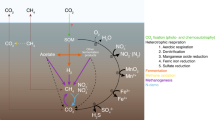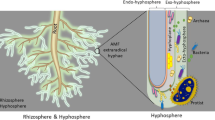Abstract
Pneumatophores are aerial roots developing from the main roots of mangrove plants away from the gravity. The below ground pneumatophore-associated soil prokaryotic community of Avicennia marina was studied by amplicon pyrosequencing (39,378 reads) during monsoon and summer seasons. Apart from the most dominant phylum Proteobacteria in both seasons, the second most were Acidobacteria (summer) and Cyanobacteria/Chloroplast (monsoon). Similarly, Acidobacteria_Gp10 and Cyanobacteria were the second most abundant at class level during summer and monsoon, respectively. Archaeal phylum Thaumarchaeota was the most abundant followed by Crenarchaeota and Euryarchaeota. The classes detected in our study were Thermoprotei, Halobacteria, and Methanomicrobia. The highest richness and diversity were observed during summer for bacteria, whereas the same phenomena for archaea in monsoon at 97 % sequence similarity. To the best of our knowledge, this is the first attempt to catalog the prokaryotic diversity of pnueumatophore-associated soil.



Similar content being viewed by others
References
Alfaro-Espinoza G, Ullrich MS (2014) Marinobacterium mangrovicola sp. nov., a marine nitrogen-fixing bacterium isolated from mangrove roots of Rhizophora mangle. Int J Syst Evol Microbiol 64:3988–3993
Alongi DM, Christoffersen P, Tirendi F (1993) The influence of forest type on microbial-nutrient relationships in tropical mangrove sediments. J Exp Mar Biol Ecol 171:201–223
Alongi DM, Trott LA, Wattayakorn G, Clough BF (2002) Below-ground nitrogen cycling in relation to net canopy production in mangrove forests of southern Thailand. Mar Biol 140:855–864
Andreote FD, Jiménez DJ, Chaves D et al (2012) The microbiome of Brazilian mangrove sediments as revealed by metagenomics. PLoS One 7:e38600
Barnard RL, Osborne CA, Firestone MK (2013) Responses of soil bacterial and fungal communities to extreme desiccation and rewetting. ISME J 7:2229–2241
Bolhuis H, Stal LJ (2011) Analysis of bacterial and archaeal diversity in coastal microbial mats using massive parallel 16S rRNA gene tag sequencing. ISME J 5:1701–1712
Boone DR, Mathrani IM, Liu Y et al (1993) Isolation and characterization of Methanohalophilus portucalensis sp. nov. and DNA reassociation study of the genus Methanohalophilus. Int J Syst Bacteriol 43:430–437
Cao H, Li M, Hong Y, Gu J-D (2011) Diversity and abundance of ammonia-oxidizing archaea and bacteria in polluted mangrove sediment. Syst Appl Microbiol 34:513–523
Cleary DFR, Smalla K, Mendonça-Hagler LCS, Gomes NCM (2012) Assessment of variation in bacterial composition among microhabitats in a mangrove environment using DGGE fingerprints and barcoded pyrosequencing. PLoS One 7:e29380
Cole JR, Wang Q, Cardenas E et al (2009) The ribosomal database project: improved alignments and new tools for rRNA analysis. Nucleic Acids Res 37:D141–D145
Cui H-L, Gao X, Yang X, Xu X-W (2011) Halolamina pelagica gen. nov., sp. nov., a new member of the family Halobacteriaceae. Int J Syst Evol Microbiol 61:1617–1621
Delong EF (1992) Archaea in coastal marine environments. Proc Natl Acad Sci USA 89:5689
Dos Santos HF, Cury JC, do Carmo FL et al (2011) Mangrove bacterial diversity and the impact of oil contamination revealed by pyrosequencing: bacterial proxies for oil pollution. PLoS One 6:e16943
Dromgoole FI (1988) Carbon dioxide fixation in aerial roots of the New Zealand mangrove Avicennia marina var. resinifera. N Z J Mar Freshw Res 22:617–619
Elshahed MS, Najar FZ, Roe BA et al (2004) Survey of archaeal diversity reveals an abundance of halophilic archaea in a low-salt, sulfide- and sulfur-rich spring. Appl Environ Microbiol 70:2230–2239
Gomes NCM, Cleary DFR, Pinto FN et al (2010) Taking root: enduring effect of rhizosphere bacterial colonization in mangroves. PLoS One 5:e14065. doi:10.1371/journal.pone.0014065
Harbison P (1986) Mangrove muds: a sink and a source for trace metals. Mar Pollut Bull 17:246–250
Herndl GJ, Reinthaler T, Teira E et al (2005) Contribution of Archaea to total prokaryotic production in the deep Atlantic Ocean. Appl Environ Microbiol 71:2303–2309
Hiiesalu I, Pärtel M, Davison J et al (2014) Species richness of arbuscular mycorrhizal fungi: associations with grassland plant richness and biomass. New Phytol 203:233–244
Jackson ML (1967) Soil chemical analysis. Prentice Hall of India Pvt Ltd, New Delhi
Jiang X-T, Peng X, Deng G-H et al (2013) Illumina sequencing of 16S rRNA tag revealed spatial variations of bacterial communities in a mangrove wetland. Microb Ecol 66:96–104
Jones RT, Robeson MS, Lauber CL et al (2009) A comprehensive survey of soil acidobacterial diversity using pyrosequencing and clone library analyses. ISME J 3:442–453
Vijaya Kumar KM, Kumara V (2013) Physico-chemical analysis of water quality of Kundapura mangrove forest, Karnataka, India. Glob J Biol Agric Heal Sci 2:111–118
Kale V, Björnsdóttir SH, Fridjónsson ÓH et al (2013) Litorilinea aerophila gen. nov., sp. nov., an aerobic member of the class Caldilineae, phylum Chloroflexi, isolated from an intertidal hot spring. Int J Syst Evol Microbiol 63:1149–1154
Kathiresan K, Bingham BL (2001) Biology of mangroves and mangrove ecosystems. Adv Mar Biol 40:81–251
Kim KK, Lee KC, Lee J-S (2011) Halogranum salarium sp. nov., a halophilic archaeon isolated from sea salt. Syst Appl Microbiol 34:576–580
Kreuzwieser J, Buchholz J, Rennenberg H (2003) Emission of methane and nitrous oxide by australian mangrove ecosystems. Plant Biol 5:423–431
Kristensen E, Flindt MR, Ulomi S et al (2008) Emission of CO2 and CH4 to the atmosphere by sediments and open waters in two Tanzanian mangrove forests. Mar Ecol Prog Ser 370:53–67
Leininger S, Urich T, Schloter M et al (2006) Archaea predominate among ammonia-oxidizing prokaryotes in soils. Nature 442:806–809
Lino T, Mori K, Uchino Y et al (2010) Ignavibacterium album gen. nov., sp. nov., a moderately thermophilic anaerobic bacterium isolated from microbial mats at a terrestrial hot spring and proposal of Ignavibacteria classis nov., for a novel lineage at the periphery of green sulfur bacteria. Int J Syst Evol Microbiol 60:1376–1382
Lugomela C, Bergman B (2002) Biological N2-fixation on mangrove pneumatophores: preliminary observations and perspectives. Ambio 31:612–613
Mochimaru H, Tamaki H, Hanada S et al (2009) Methanolobus profundi sp. nov., a methylotrophic methanogen isolated from deep subsurface sediments in a natural gas field. Int J Syst Evol Microbiol 59:714–718
Moor C, Lymberopoulou T, Dietrich VJ (2001) Determination of heavy metals in soils, sediments and geological materials by ICP-AES and ICP-MS. Microchim Acta 136:123–128
Mukherjee A, De M, Das S et al (2012) Rate of salt excretion by salt excreting mangroves of sundarban under varying environmental conditions. Glob Adv Res J Environ Sci Toxicol 1:1–9
Naether A, Foesel BU, Naegele V et al (2012) Environmental factors affect acidobacterial communities below the subgroup level in grassland and forest soils. Appl Environ Microb 78:7398–7406
Nielsen T, Andersen F (2003) Phosphorus dynamics during decomposition of mangrove (Rhizophora apiculata) leaves in sediments. J Exp Mar Biol Ecol 293:73–88
Ovreås L, Forney L, Daae FL et al (1997) Distribution of bacterioplankton in meromictic Lake Saelenvannet, as determined by denaturing gradient gel electrophoresis of PCR-amplified gene fragments coding for 16S rRNA. Appl Environ Microbiol 63:3373
Pelegri SP, Rivera-Monroy VH, Twilley RR (1997) A comparison of nitrogen fixation (acetylene reduction) among three species of mangrove litter, sediments, and pneumatophores in south Florida, USA. Hydrobiologia 356:73–79
Pester M, Rattei T, Flechl S et al (2012) amoA-based consensus phylogeny of ammonia-oxidizing archaea and deep sequencing of amoA genes from soils of four different geographic regions. Environ Microbiol 14:525–539
Pires ACC, Cleary DFR, Almeida A et al (2012) Denaturing gradient gel electrophoresis and barcoded pyrosequencing reveal unprecedented archaeal diversity in mangrove sediment and rhizosphere samples. Appl Environ Microbiol 78:5520–5528
Purvaja R, Ramesh R, Frenzel P (2004) Plant-mediated methane emission from an Indian mangrove. Glob Chang Biol 10:1825–1834
Quaiser A, Ochsenreiter T, Lanz C et al (2003) Acidobacteria form a coherent but highly diverse group within the bacterial domain: evidence from environmental genomics. Mol Microbiol 50:563–575
Ren J, Yan B, Hong K (2012) Comparison of bacterial and archaeal community of mangrove soil under different vegetation in Dongzhaigang, Hainan Island. Acta Microbiol Sin 52:736–743
Rhoades JD, Manteghi NA, Shouse PJ et al (1989) Soil electrical conductivity and soil salinity: new formulations and calibrations. Soil Sci Soc Am J 53:433–439
Santra SC, Pal UC, Maity H et al (1988) Blue-green algae in saline habitats of West Bengal: a systematic account. Biol Membr 14:81–108
Singh N, Kendall MM, Liu Y, Boone DR (2005) Isolation and characterization of methylotrophic methanogens from anoxic marine sediments in Skan Bay, Alaska: description of Methanococcoides alaskense sp. nov., and emended description of Methanosarcina baltica. Int J Syst Evol Microbiol 55:2531–2538
Soto-Ramírez N, Sánchez-Porro C, Rosas S et al (2007) Halomonas avicenniae sp. nov., isolated from the salty leaves of the black mangrove Avicennia germinans in Puerto Rico. Int J Syst Evol Microbiol 57:900–905
Sparling GP, Whale KN, Ramsay AJ (1985) Quantifying the contribution from the soil microbial biomass to the extractable P levels of fresh and air-dried soils. Soil Res 23:613–621
Suzuki T, Nakamura T, Fuse H (2012) Isolation of two novel marine ethylene-assimilating bacteria, Haliea Species ETY-M and ETY-NAG, containing particulate methane monooxygenase-like genes. Microbes Environ 27:54–60. doi:10.1264/jsme2.ME11256
Takai K, Abe M, Miyazaki M et al (2013) Sunxiuqinia faeciviva sp. nov., a facultatively anaerobic organoheterotroph of the Bacteroidetes isolated from deep subseafloor sediment. Int J Syst Evol Microbiol 63:1602–1609
Tedersoo L, Bahram M, Polme S et al (2014) Global diversity and geography of soil fungi. Science 346(80):1–10
Vazquez P, Holguin G, Puente ME et al (2000) Phosphate-solubilizing microorganisms associated with the rhizosphere of mangroves in a semiarid coastal lagoon. Biol Fertil Soils 30:460–468
Wang Q, Garrity GM, Tiedje JM, Cole JR (2007) Naive Bayesian classifier for rapid assignment of rRNA sequences into the new bacterial taxonomy. Appl Environ Microbiol 73:5261–5267
Wang Y, Sheng H-F, He Y et al (2012) Comparison of the levels of bacterial diversity in freshwater, intertidal wetland, and marine sediments by using millions of illumina tags. Appl Environ Microbiol 78:8264–8271
Wang Y, Sheng HF, He Y et al (2012) Comparison of the levels of bacterial diversity in freshwater, intertidal wetland, and marine sediments by using millions of illumina tags. Appl Environ Microb 78:8264–8271
Wuchter C, Abbas B, Coolen MJL et al (2006) Archaeal nitrification in the ocean. Proc Natl Acad Sci USA 103:12317–12322
Wuchter C, Schouten S, Boschker HTS, Sinninghe Damsté JS (2003) Bicarbonate uptake by marine Crenarchaeota. FEMS Microbiol Lett 219:203–207
Xu X-W, Wu Y-H, Wang C-S et al (2007) Haloferax larsenii sp. nov., an extremely halophilic archaeon from a solar saltern. Int J Syst Evol Microbiol 57:717–720
Acknowledgments
Author DSL thanks Lady Tata memorial trust, Mumbai for providing Junior (2012–2014) and Senior research scholarship (2014–2016).
Author information
Authors and Affiliations
Corresponding author
Ethics declarations
Conflict of interest
The authors declare that there is no conflict of interest in this manuscript.
Electronic Supplementary Material
Below is the link to the electronic supplementary material.
Rights and permissions
About this article
Cite this article
Sanka Loganathachetti, D., Sadaiappan, B., Poosakkannu, A. et al. Pyrosequencing-Based Seasonal Observation of Prokaryotic Diversity in Pneumatophore-Associated Soil of Avicennia marina . Curr Microbiol 72, 68–74 (2016). https://doi.org/10.1007/s00284-015-0920-9
Received:
Accepted:
Published:
Issue Date:
DOI: https://doi.org/10.1007/s00284-015-0920-9




